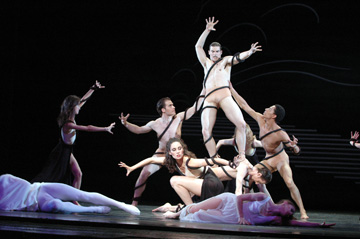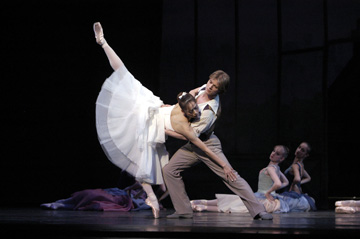Lincoln
Center Festival
Ashton Celebration
Home to Roost
“Dante Sonata”, “The Two Pigeons”
Birmingham Royal Ballet
Metropolitan Opera House
New York, NY
July 10, 2004
by Mary Cargill
copyright
© 2004 by Mary Cargill
published July 11, 2004
 For
years Ashton’s “Dante Sonata” was considered a lost
ballet, powerful in its time (the looming World War II), but, except for
some distinctive photographs, irrecoverable. But in 2000 David Bintley
of the Birmingham Royal Ballet, with some of its original cast, reconstructed
it for his company. The blessed Ashton Celebration is its first viewing
in New York, but, I hope, not its last. It is a simple and powerful statement
of the despair and futility of conflict. Yes, it is “about”
World War II, but it still resonates. The black and white designs are
as beautiful and varied as the most artfully made black and white film,
and the shapes that the groups make have an austere and fascinating power.
There is no feel-good triumph of good or a facile despair (so trendy nowadays)
in seeing innocence destroyed. Both the Children of Light and the Children
of Darkness loose in the final scene, and the audience is left with a
hollow feeling of the utter futility of war, combined with an overwhelming
sympathy for those lost.
For
years Ashton’s “Dante Sonata” was considered a lost
ballet, powerful in its time (the looming World War II), but, except for
some distinctive photographs, irrecoverable. But in 2000 David Bintley
of the Birmingham Royal Ballet, with some of its original cast, reconstructed
it for his company. The blessed Ashton Celebration is its first viewing
in New York, but, I hope, not its last. It is a simple and powerful statement
of the despair and futility of conflict. Yes, it is “about”
World War II, but it still resonates. The black and white designs are
as beautiful and varied as the most artfully made black and white film,
and the shapes that the groups make have an austere and fascinating power.
There is no feel-good triumph of good or a facile despair (so trendy nowadays)
in seeing innocence destroyed. Both the Children of Light and the Children
of Darkness loose in the final scene, and the audience is left with a
hollow feeling of the utter futility of war, combined with an overwhelming
sympathy for those lost.
The performance I saw, led by Lei Zhao, Jenna Roberts, and Iain Mackay as the Children of Light and Angela Paul (particularly fierce) and Andy Rietschel as the Children of Darkness combined the energy of modern dancers (bare feet grabbing the floor, arms gripping the air, and hair flying) with the plasticity and molded, sculptural qualities of the best of ballet. It was simply shattering.
 Hope,
though, followed despair, since “Dante Sonata” was followed
by “The Two Pigeons”, one of Ashton’s sunny, love-drenched
valentines, but, like all of Ashton, it has subtle depths. It hasn’t
been seen in the United States in the early 1960’s, when, reportedly,
it wasn’t very successful. The story is simple; a painter and his
model are working, but the model, the young girl (Ambra Vallo) is bored
and restless, and the young man (Chi Cao) is getting irritated. Her friends
enter the studio, and they dance. Then a wandering band of gypsies (where
would ballet be without them?) burst in and dance, led by the gypsy girl
(Asta Bazeviciúte) and her lover (Iain Mackay). The gypsy girl
entices the young painter, and when they leave, he decides to follow.
The second act is set in the gypsy camp, where the gypsies dance. The
young man joins them, and dances too, until they rob him, and toss him,
tied in ropes, from their camp. He than goes home to find the young girl
waiting for him.
Hope,
though, followed despair, since “Dante Sonata” was followed
by “The Two Pigeons”, one of Ashton’s sunny, love-drenched
valentines, but, like all of Ashton, it has subtle depths. It hasn’t
been seen in the United States in the early 1960’s, when, reportedly,
it wasn’t very successful. The story is simple; a painter and his
model are working, but the model, the young girl (Ambra Vallo) is bored
and restless, and the young man (Chi Cao) is getting irritated. Her friends
enter the studio, and they dance. Then a wandering band of gypsies (where
would ballet be without them?) burst in and dance, led by the gypsy girl
(Asta Bazeviciúte) and her lover (Iain Mackay). The gypsy girl
entices the young painter, and when they leave, he decides to follow.
The second act is set in the gypsy camp, where the gypsies dance. The
young man joins them, and dances too, until they rob him, and toss him,
tied in ropes, from their camp. He than goes home to find the young girl
waiting for him.
The two pigeons are both metaphors for the young man and the young girl, and real pigeons, who appear at various appropriate intervals—flying off into the distance as the young man decides to leave, sitting on the man’s shoulder as he returns home, and finally, as the lovers reunite, one flies in on cue to join its mate. I knew it was coming, but still got a lump in my throat at the simple musical perfection of that moment.
 The
choreography, especially for the gypsy camp, is wonderfully colorful and
inventive—would that gypsies in other ballets were so interesting!
Ashton’s gypsies are classical; they are in point shoes, and the
choreography has a symmetrical order and structure, but it is spiced with
rich back bends and luxurious shoulder movements, not to mention some
beautiful costumes. The gypsy girl gets a beautiful pizzicato solo, full
of little jumps and hops, which is a gem. Bazeviciúte is a tall,
luxurious dancer, with precise footwork, and she had an elegant touch;
this wasn’t some heavy breathing, smoldering Carmen-imitation, but
a classical dancer in a light-hearted but very rich ballet.
The
choreography, especially for the gypsy camp, is wonderfully colorful and
inventive—would that gypsies in other ballets were so interesting!
Ashton’s gypsies are classical; they are in point shoes, and the
choreography has a symmetrical order and structure, but it is spiced with
rich back bends and luxurious shoulder movements, not to mention some
beautiful costumes. The gypsy girl gets a beautiful pizzicato solo, full
of little jumps and hops, which is a gem. Bazeviciúte is a tall,
luxurious dancer, with precise footwork, and she had an elegant touch;
this wasn’t some heavy breathing, smoldering Carmen-imitation, but
a classical dancer in a light-hearted but very rich ballet.
Ambra Vallo as the young girl seemed a bit angular; the role was made for the melting, rounded Lynn Seymour, and she was also a bit coy during the opening scene, but the final reconciliation was very well done. Chi Cao is a fine dancer, and he got to show off his form in the gypsy scene. His scene where he dances with his hands tied was as moving, in its more gentle way, as the Prodigal’s crawl home. Indeed, the lesson of “The Two Pigeons” is the lesson of “The Prodigal Son”—beware of tall, beautiful women, and after all, home is best. I hope that “The Two Pigeons” finds a permanent home somewhere in the United States—the cheering audience clearly doesn’t want to wait another 40 years to see it again.
Photos, all
taken on July 7 (and of a different cast in "The Two Pigeons")
by Stephanie Berger:
First: Birmingham Royal Ballet in "Dante Sonata"
Second and third: BRB in "The Two Pigeons."
Originally
published:
July 11, 2004
www.danceviewtimes.com
Volume 2, Ashton Section
Copyright
©2004 by Mary Cargill
|
|
|